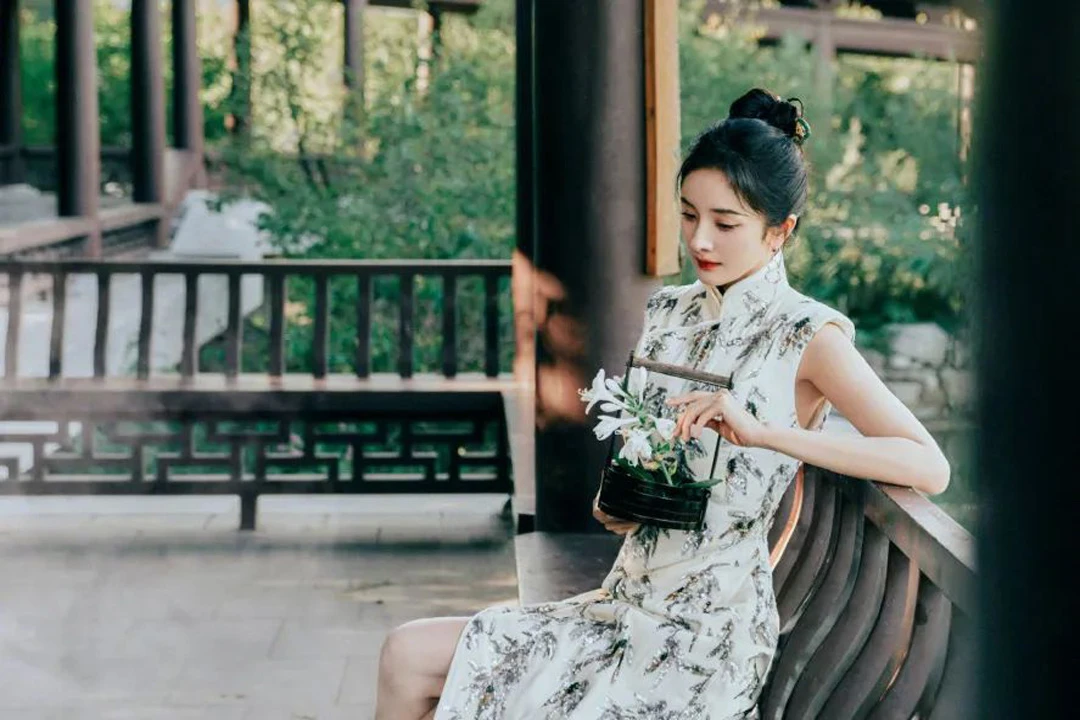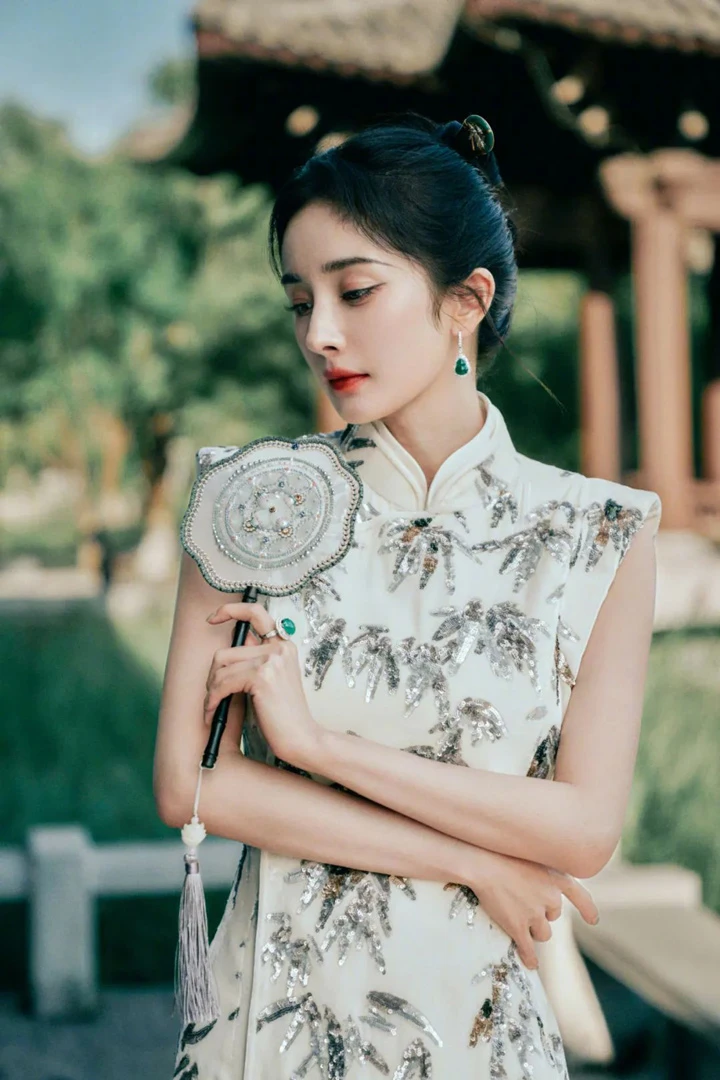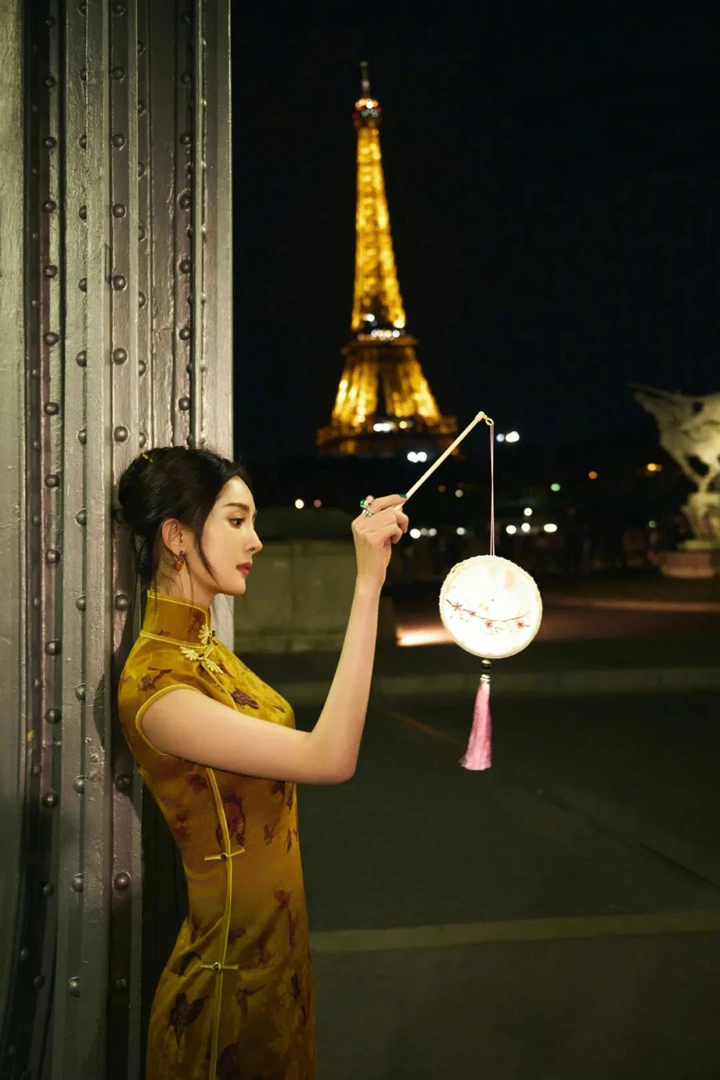In recent times, Yang Mi’s neo-traditional cheongsam styles have captivated fashion enthusiasts, showcasing a perfect blend of grace, elegance, and the unique beauty of Eastern women. As a global brand ambassador, Yang Mi was invited to attend the LOEWE fashion show in Paris, where she donned a yellow embroidered cheongsam and posed for a photoshoot with the iconic Eiffel Tower in the background. The striking images showcased the collision and fusion of Eastern and Western historical cultures, exuding a distinct charm and allure.
During the 2024 Henan TV Spring Festival Gala, Yang Mi stunned the audience with five different Hanfu (traditional Chinese clothing) looks from various periods. Among them was a simple and elegant white pearl-embellished cheongsam, which represented the most popular women’s fashion style during the Republic of China era. With every movement, Yang Mi exuded an enchanting and graceful aura.
In the recently popular drama “Harbin 1944,” Yang Mi portrays the lead character, Guan Xue, and showcases several highly representative classical Chinese cheongsam styles. These looks not only enhance the character’s image but also vividly depict the historical background of the era.
As we enter the 21st century, with the global spread of Chinese culture, the cheongsam has frequently appeared at film festivals, international fashion shows, and various cultural exchange events, becoming an essential medium for showcasing the beauty of Chinese culture to the world.
The cheongsam, also known as qipao, is a traditional Chinese dress that originated from the Manchu ethnic group during the Qing Dynasty (1644-1912). Initially, it was a loose-fitting, long robe worn by Manchu women, featuring a high collar, short sleeves, and a side slit. Over time, the cheongsam evolved, incorporating elements from Western fashion and adapting to the changing tastes and needs of modern women.
In the 1920s and 1930s, the cheongsam underwent a significant transformation in Shanghai, the fashion capital of China at the time. The dress became more form-fitting, accentuating the curves of the female body, and the side slits were raised higher to allow for easier movement. This modernized version of the cheongsam quickly gained popularity among upper-class women and became a symbol of sophistication and femininity.
The cheongsam’s allure lies not only in its aesthetic appeal but also in its ability to represent the essence of Chinese culture and values. The dress embodies the Confucian ideals of modesty, refinement, and grace, while also reflecting the changing roles and status of women in Chinese society.
In recent years, there has been a resurgence of interest in traditional Chinese clothing, with many designers and celebrities embracing the cheongsam and incorporating it into their fashion choices. Yang Mi, a prominent actress and fashion icon in China, has been at the forefront of this trend, showcasing the versatility and timeless beauty of the cheongsam through her various appearances and roles.
By wearing neo-traditional cheongsam styles, Yang Mi not only pays homage to her cultural heritage but also demonstrates how the dress can be adapted to suit modern aesthetics and occasions. Her choice to wear a cheongsam at the LOEWE fashion show in Paris, for example, highlights the garment’s potential to bridge cultures and captivate international audiences.
Similarly, Yang Mi’s portrayal of Guan Xue in “Harbin 1944” and her stunning Hanfu looks at the Henan TV Spring Festival Gala showcase the cheongsam’s ability to transport viewers to different eras and evoke a sense of nostalgia and pride in Chinese history and culture.
As the cheongsam continues to gain global recognition and appreciation, it has become an important tool for cultural diplomacy and soft power. When worn by influential figures like Yang Mi at international events, the cheongsam serves as a visual ambassador for Chinese culture, sparking curiosity and admiration among foreign audiences.
Moreover, the cheongsam’s increasing presence on the global stage has led to a renewed interest in traditional Chinese craftsmanship and textiles. Many contemporary cheongsam designs feature intricate embroidery, delicate silk fabrics, and hand-painted motifs, highlighting the exceptional skills and artistry of Chinese artisans. By promoting these traditional techniques and materials, the cheongsam not only preserves cultural heritage but also supports the livelihoods of craftspeople and contributes to the sustainability of these ancient art forms.
The cheongsam’s influence extends beyond the realm of fashion, as it has become a source of inspiration for various creative industries. In recent years, numerous films, television series, and photoshoots have featured characters or models wearing cheongsams, showcasing the dress’s enduring appeal and its ability to captivate audiences across different mediums.
Furthermore, the cheongsam has played a role in empowering women and challenging traditional gender roles. By wearing a cheongsam, a woman can express her individuality, confidence, and pride in her cultural identity. The dress’s form-fitting silhouette and high collar, once seen as restrictive and oppressive, have been reinterpreted as symbols of strength and self-assurance, allowing women to reclaim and redefine the narrative surrounding the garment.
As Chinese culture continues to gain global prominence, the cheongsam will undoubtedly remain an essential ambassador for the country’s rich history, values, and aesthetics. Through the efforts of trendsetters like Yang Mi, who fearlessly embrace and modernize the cheongsam, the dress will continue to evolve and adapt to the changing times, while never losing its core essence and cultural significance.
In a world that increasingly values diversity, inclusivity, and cultural exchange, the cheongsam serves as a powerful reminder of the importance of preserving and celebrating traditional heritage. By wearing a cheongsam, one not only pays tribute to the past but also contributes to a more vibrant and interconnected future, where fashion becomes a universal language that brings people together and fosters mutual understanding and appreciation.
As we move forward, it is crucial to recognize the role of cultural icons like Yang Mi in shaping public perception and promoting the beauty and value of traditional clothing. Through their influence and visibility, they have the power to inspire younger generations to engage with their cultural roots and take pride in their heritage.
In conclusion, Yang Mi’s neo-traditional cheongsam styles serve as a testament to the enduring charm and relevance of this iconic Chinese dress. By embracing the cheongsam and showcasing its versatility and beauty on the global stage, Yang Mi has contributed to the ongoing dialogue between tradition and modernity, East and West, and has helped to ensure that the cheongsam remains a vital and celebrated part of Chinese culture for generations to come.



